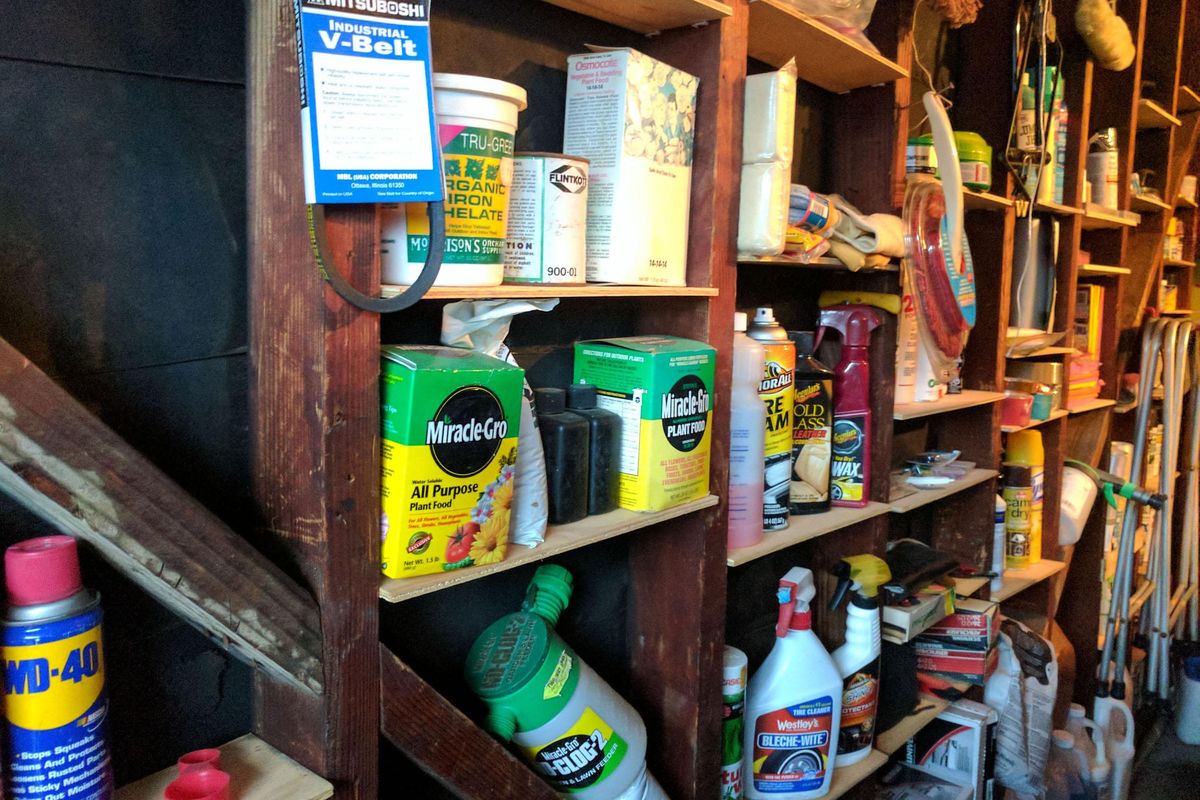Ask the builder: Cheap and easy way to build garage shelves

DEAR TIM: I need some creative garage shelving ideas. I’ve got a limited budget, bare stud walls with no insulation and I’ve accumulated countless small boxes of nails and screws, spray paint cans, boxes of fertilizer and so forth. Please save yourself the trouble telling me about all the fancy cabinets and shelving units. I just don’t have the money. All I can afford is $30 at the most. – Mona G., Lost Creek, Kentucky
DEAR MONA: I’ve got great news for you. All of the things you need for a simple solution are aligned. This is indeed your lucky day.
Allow me to share a story with you. I’ve got a great friend who lives in Southern California. I visit him on a fairly regular basis. He and his wife have a wonderful detached garage that’s just like yours.
It has a durable cement stucco outer covering, but the inside of the garage is just bare 2-by-4 walls. He’s accumulated all the things you’ve described and much more over the 60-plus years he’s lived in this home.
Several times he’s asked me about ways to try to tame the clutter, and I have recommended putting up a shelf that overhangs the hoods of the cars. Many garages have a vast amount of wasted space in the air and this shelf would be perfect for his larger items.
But he had all sorts of small things covering the floor of the garage, making it nearly impossible to find anything. I’ve had the same problem in my own garage.
Two months ago I visited him, and he took me out to the garage. The floor was clean. I could see concrete everywhere. All of his cans, spray bottles, boxes of plant fertilizer, nails and screws, bottles of motor oil, paint roller covers, brushes – you name it – were organized nicely tucked inside the wall stud spaces.
He and his industrious wife had purchased one sheet of 1/4-inch plywood and had it ripped into 4-inch-wide strips. This yielded – are you sitting down? – an astonishing 88 linear feet of shelving.
All he had to do was use a simple hand saw to cut the shelves to the width of the space in between the vertical wall studs. They maximized the storage space by doing their best to organize things that were related to one another and the same height.
Doing this allowed them to put as many shelves as possible in one wall cavity in between two wall studs.
As if that weren’t clever enough, he and his wife came up with a simple yet strong way to support each shelf. They used electrical cable staples as tiny shelf cleats. It took just four – two to each side – to support each shelf. For shelves that would support fairly lightweight items, I told him he could have used small 6-penny finish nails. These are very inexpensive.
You don’t have to have a fancy tool to get the shelves level in both directions. A common torpedo level is all you need to get the shelf level side-to-side. You can use a shelf panel that’s got a nice square cut on it to create the level line that becomes your guide for the cable staples or finish nails.
All you do is determine the height you want the shelf, press the shelf flat up against the side of a wall stud and trace a pencil line along the short edge of the shelf. Assuming the walls of the garage are plumb, this will automatically create a 90-degree level shelf.
My friend decided some shelves that held liquids shouldn’t be level. He wanted a slight backward tilt so the bottles and cans would lean back toward the wall. This is easy to do by just putting one cable staple above the pencil line and the other one below.
Guess what? Even if you had told me your garage walls were insulated and drywalled, you could still do this. You’d have to spend a little more money to buy some 2-by-4s, but you could probably find enough money to buy them in your car’s cup holders or underneath your couch cushions.
My garage is drywalled, and as soon as it warms up I’m going to build a simple wall out of 2-by-4s. I’ll then use a few simple L brackets to secure the bare wall to the studs behind the drywall. Then I just have to do what I described above to organize all my small things.
Many garages have a foundation ledge that sticks up above the concrete floor and it’s the perfect spot to rest this bare wall. I can’t wait to get started here at my own home.
Need an answer? All of Tim’s past columns are archived for free at www.AsktheBuilder.com. You can also watch hundreds of videos, download Quick Start Guides and more, all for free.